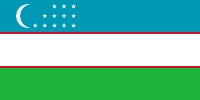Bilateral German-Uzbek Project
AQUAGRAPH: Absorbing boundary conditions for quantum graphs
Programme Re-invitation Programme for Former Scholarship Holders, 2018
financed by DAAD
(09/2018)
| |
Summary
This project aims at the study of wave dynamics in quantum networks with transparent branching points.
The latter means that wave/particle transmission through the network branching points (vertices) occurs without reflection.
This will be done by solving linear and nonlinear Schrödinger equations on metric graphs
for which so-called absorbing (transparent)
vertex boundary conditions at the graph vertices are imposed in order to provide
the transparency of the network.
Applications of the results for modeling and design different optical
fiber networks and branched nanoscale systems will be discussed concisely.
Introduction
Quantum graphs have been shown to serve as accurate models for the study
of quantum transport and spectral statistics in nanosized systems.
Recently quantum graphs are studied experimentally by using microwave networks
consisting of coaxial waveguides.
Zero point energy in quantum graphs may
play important role in various systems (e.g., polymers, molecular networks,
microwave networks and other supramolecular structures), whose dynamics can be
modelled by quantum graphs, as well as in nanomechanics.
The problem of absorbing (transparent) boundary conditions (ABCs) for wave equations has attracted much
attention in different practically important contexts. Such boundary conditions describe
absorption of particles and waves in their transmission from one domain to another one.
From the mathematical point
of view, absorbing boundary conditions are the same as those describing reflectionless
transmission of particles (waves)
through the boundary of a given domain. Therefore, one uses similar terminology
for the boundary conditions of both
types of processes, calling them absorbing or transparent boundary conditions.
For both processes, the boundary conditions can be derived by factorization of the differential operator,
corresponding
to a wave equation, which in general lead to a complicated equations for the boundary conditions.
Explicit form of
such boundary conditions are much complicated than those of Dirichlet, Neumann and Robin conditions.
For absorbing boundary conditions the wave equation cannot be solved analytically and always requires using
numerical methods. Depending on the type of the wave equation, they require different discretization
schemes, which vary also for the types of the process. Here we will apply absorbing boundary conditions
to quantum graphs
considering the problem of reflectionless transmission of particle through the graph branching point (vertex).
In this project we will extend the classical derivation of ABCs for Schrödinger equations to
the case of quantum graphs. First we will consider the simplest, star-shaped graph.
Scientific Objectives
Within this research project we address two problems:
the first problem can be called
"linear wave dynamics in
quantum graphs with transparent vertices", while the second one is called
"soliton dynamics in transparent networks".
The specific objectives of the project includes the following:
- Particle dynamics in transparent quantum networks. Linear Schrödinger equation on metric
graphs will be solved
by imposing transparent vertex boundary conditions.
- Soliton transport in networks with transparent networks.
Nonlinear Schrödinger equation will be solved by imposing
transparent vertex boundary conditions. Soliton dynamics in such system will be modeled.
Constraints providing reflectionless
transport of solitons in networks will be derived.
- Computation of conductance and optical conductivity of
transparent networks interacting with external time-periodic field.
 German team:
German team:
 Uzbek team:
Uzbek team:
 German institution:
German institution:
 Uzbek Institution:
Uzbek Institution:
- State Testing Center, Uzbekistan, 100084, Tashkent, Uzbekistan.
- Laboratory for Advanced Studies, Turin Polytechnic University in Tashkent, 17 Niyazov Str. 100095 Tashkent, Uzbekistan.
Publications related to the Project
- J.R. Yusupov, M. Ehrhardt, Kh.Sh. Matyokubov and D.U. Matrasulov,
Driven transparent quantum graphs,
Preprint 23/19, November 2023.
- J.R. Yusupov, Kh.Sh. Matyokubov, M. Ehrhardt and D.U. Matrasulov,
Manakov system on metric graphs: Modeling the reflectionless propagation of vector solitons in networks,
Physics Letters A, Volume 479 (2023), 128928.
DOI: 10.1016/j.physleta.2023.128928.
- M.E. Akramov, J.R. Yusupov, M. Ehrhardt, H. Susanto and D.U. Matrasulov,
Transparent boundary conditions for the nonlocal nonlinear Schrödinger equation:
A model for reflectionless propagation of PT-symmetric solitons,
Physics Letters A, Volume 459, January 2023, 128611.
DOI: 10.1016/j.physleta.2022.128611.
- K.K. Sabirov, J.R. Yusupov, M. Ehrhardt and D.U. Matrasulov,
Transparent boundary conditions for the sine-Gordon equation:
Modeling the reflectionless propagation of kink solitons on a line,
Physics Letters A, Vol. 423 (2022), 127822.
DOI: 10.1016/j.physleta.2021.127822.
- K.K. Sabirov, J.R. Yusupov, M.M. Aripov, M. Ehrhardt and D.U. Matrasulov,
Reflectionless propagation of Manakov solitons on a line:
A model based on the concept of transparent boundary conditions,
Physical Review E, Vol. 103, No. 4 (2021), 043305.
DOI: 10.1103/PhysRevE.103.043305
- J.R. Yusupov, K.K. Sabirov, Q.U. Asadov, M. Ehrhardt and D.U. Matrasulov,
Dirac Particles in Transparent Quantum Graphs:
Tunable transport of relativistic quasiparticles in branched structures,
Physical Review E, Volume 101, Number 6 (June 2020), 062208.
DOI: 10.1103/PhysRevE.101.062208
- J.R. Yusupov, K.K. Sabirov, M. Ehrhardt and D.U. Matrasulov,
Transparent nonlinear networks,
Physical Review E, Vol. 100, No. 3 (September 2019), 032204.
DOI: 10.1103/PhysRevE.100.032204
- J.R. Yusupov, K.K. Sabirov, M. Ehrhardt and D.U. Matrasulov,
Transparent Quantum Graphs,
Physics Letters A, Volume 383, Issue 20 (July 2019), 2382-2388.
DOI:10.1016/j.physleta.2019.04.059
Talks related to the Project
- J. Yusupov,
Transparent quantum graphs: An effective model for the construction of ballistic quantum networks,
October 26, 2018, Mathematisches Kolloquium, TU Ilmenau, Germany.
- J. Yusupov,
Transparent quantum graphs: Reflectionless wave transport on branched quantum waveguides,
November 16, 2018, Laboratory for Advanced Studies,
Heat Physics Department of the Uzbek Academy of Sciences, Tashkent, Uzbekistan.
- J. Yusupov,
Quantum Networks with Reflectionless Branching Points,
Uzbek-Israel joint international conference
STEMM: Science-Technology-Education-Mathematics-Medicine,
Bukhara-Samarkand-Tashkent, Uzbekistan, May 13-17, 2019.
- J. Yusupov,
Transparent boundary conditions for nonlinear evolution equations in low-dimensional domains,
International Summer School and Conference
on
Mathematics for the Micro/Nano-World:
From soliton dynamics, nonlinear optics to quantum science and technology,
Samarkand, Uzbekistan, September 18-22, 2023.



